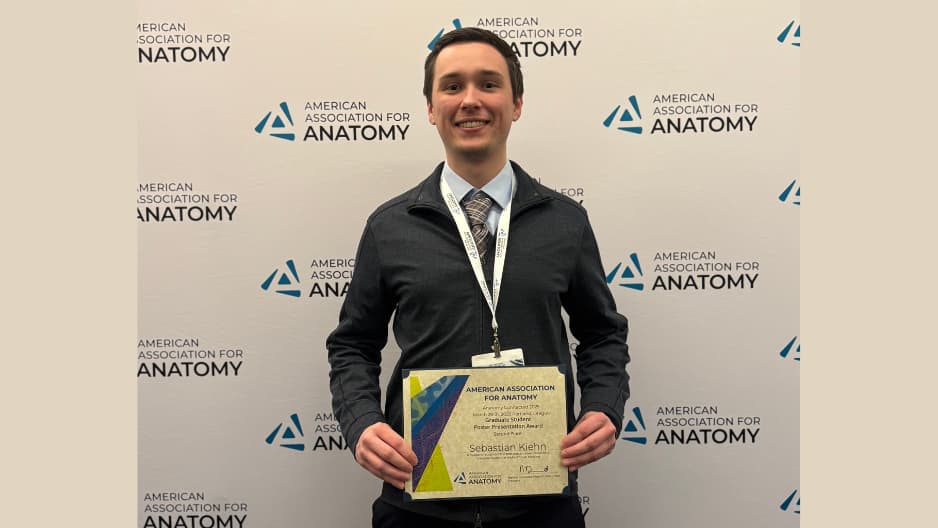Sebastian Kiehn, a third-year medical student at the Lewis Katz School of Medicine (Katz), recently presented his research at the annual meeting of the American Association for Anatomy (AAA) held in Portland, Oregon, from March 28 to 31, 2025. Conducted under the mentorship of Steven N. Popoff, Ph.D., Chair and Professor, Biomedical Education and Data Science, and Nicole Griffin, PhD, Professor, Biomedical Education and Data Science, Kiehn's study focused on "Mapping the Common Carotid Artery Bifurcation in Relation to Anterior Neck Landmarks."
Reflecting on what drew him to this project, Kiehn shared, "I got interested in this project because I want to be a surgeon, and I think it’s really important to build a strong foundation in anatomy early on. The carotid artery is in an anatomically complex area of the neck, so the dissections were challenging but also really engaging. I also liked that there’s a clinical side to it. Since the carotid bifurcation is a common site for things like carotid artery disease, it felt like the work could have real implications for surgery and patient care down the line." The study used palpable landmarks such as the hyoid bone and thyroid prominence to classify the height of the carotid bifurcation and measured its relation to important structures like the hypoglossal nerve and the angle of the mandible.
Regarding the significance of the findings, Kiehn explained, "We found that the higher the carotid bifurcation was in the neck, the closer it tended to be to both the hypoglossal nerve and the angle of the mandible. That’s what we expected going in, but it was great to see a really strong linear correlation across the different location groups we looked at. It suggests that surgeons might be able to use these palpable landmarks to estimate how close the bifurcation is to important structures. This could help in assessing surgical risk, especially in procedures like carotid endarterectomy." Despite occasional challenges, such as encountering unusual anatomical variations, Sebastian emphasized the importance of precision and adaptability: "At first, I thought maybe I had made a mistake during the dissection, so I went over everything again with Dr. Popoff... After double-checking everything, we realized it was just an anatomical variation that isn’t really well documented in the literature."
Kiehn credited his mentors for their vital role in the research process: "Dr. Popoff and Griffin were both incredible mentors and were involved in every part of the project. They taught me everything I know about doing good dissections, helped guide me through the data analysis process, and gave me really helpful and honest feedback on my writing, which made a big difference. I learned a lot from them, not just about anatomy, but also how to think like a researcher and communicate findings clearly."
The findings of Kiehn’s study emphasize the importance of incorporating detailed anatomical knowledge to navigate the complexities of carotid artery anatomy and optimize surgical outcomes. His second-place award for Best Poster Presentation by a Graduate Student at the AAA annual meeting showcases the significance of his work. Dr. Popoff expressed his pride in Kiehn’s achievement, saying, "I am exceptionally proud of his accomplishment since his study was judged among the best of a highly competitive pool of dozens of studies presented by medical and graduate students from around the world at an international meeting. Sebastian is currently in the final stages of preparing a manuscript, and I look forward to its publication in the near future."
Winning the award was a rewarding milestone for Kiehn: "It felt really rewarding! I was honored to get recognition for all the work that went into the project. Of course this was a group effort, so I think our whole team, including Dr. Popoff, Dr. Griffin, Lena Duenas [third year MD student, Class of 2026], and many others should be proud of what we put together." He now looks forward to completing the manuscript and continuing to contribute to the advancement of surgical anatomy and patient care.

